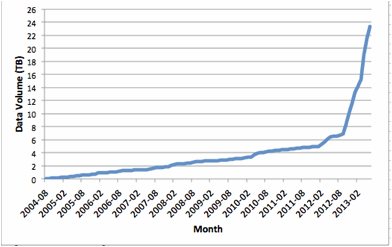Director’s Introduction
Taft Armandroff, Director, WMKO
 Welcome to our summer 2013 Newsletter for observers and prospective observers at W. M. Keck Observatory (WMKO). My introduction features the celebration of 20 years of scientific observations with the Keck I Telescope, new observing time exchange partnerships, and awards for scientists in our observing community.
Welcome to our summer 2013 Newsletter for observers and prospective observers at W. M. Keck Observatory (WMKO). My introduction features the celebration of 20 years of scientific observations with the Keck I Telescope, new observing time exchange partnerships, and awards for scientists in our observing community.
The first scientific observations with the Keck I telescope and NIRC instrument were made on 16 March 1993. Keck Observatory marked the 20th anniverary of this milestone this past March with a week of celebratory events. The extraordinary history of the W. M. Keck Observatory, our rich legacy of scientific discoveries and our plans for future scientific leadership were fully portrayed through the many facets of this unique astronomy celebration. “Keck Week” featured a science meeting, a fundraising gala, the dedication of our new MOSFIRE instrument, an open house at Keck Headquarters, a staff party, and even a tennis tournament. In addition to raising funds for our newest instrument in development, the Keck Cosmic Web Imager, the 20th anniversary events succesfully engaged the key constituencies of the observatory, including research astronomers, partner university leadership, private donors, federal funders, WMKO staff, the media, and the public. Keck Observatory also garnered much positive media attention locally and globally.
Of significant interest to readers of this Newsletter are the talks from the Keck Observatory 20th Anniversary Science Meeting which have captured WMKO’s major scientific contributions. We have been making these wonderful presentations available to “Keck Nation,” one or two per week; see http://keckobservatory.org/keck_week_science_meeting_videos.
I am immensely grateful to the many people who made Keck Week successful, including our Advancement Team led by Debbie Goodwin, the Scientific and Local Organizing Committees for the Science Meeting, the astronomers who gave presentations, the Keck staff and other volunteers who made the 20th Anniversary Open House and other events possible, and our sponsors.
The development and upgrading of instrumentation and related facilities have played an important role in the Observatory’s first 20 years and continue to be important to its future. One of the ways we have funded these developments is through the exchange of a modest number of observing nights with other institutions. This has enabled a number of strategic initiatives for WMKO that would not have been possible otherwise. For example, approximately half of the funding for our powerful MOSFIRE instrument was provided by the National Science Foundation / National Optical Astronomy Observatory (NOAO) Telescope System Instrumentation Program (TSIP). In this TSIP collaboration, WMKO provided observing time to the broad U.S. community, allocated by the NOAO Time Allocation Committee (TAC). By agreement with our Board and Science Steering Committee (SSC), we have limited these exchanges to 24 nights per year, with Caltech and the University of California (UC) each contributing 12 nights per year.
I am pleased to report that we have initiated a collaborative time exchange agreement with the Australian National University (ANU) Research School of Astronomy and Astrophysics (RSAA). This is similar to the exchanges with TSIP and separately with Yale University. Our agreement with ANU has a term of five years and exchanges 15 nights per year starting in semester 2013B. These nights are evenly distributed between the Keck I and Keck II telescopes and also over lunar phase.
In order to foster such collaborations and exchanges, we sought to exchange a small number of additional nights per year. A new agreement with the University of Hawaii (UH) helps achieve this goal. The new agreement memorializes UH contributing four nights per year to TSIP-like exchanges alongside the 12 nights each provided by UC and Caltech. Thus, WMKO can now exchange up to 28 nights per year with partners. As part of this broader collaboration with UH, UH has gained an observer seat at meetings of the CARA Board (Keck Observatory’s governing Board). UH is also now represented by an additional non-voting member on our SSC. UH Institute for Astronomy Director Guenther Hasinger fills both of these new roles.
It is always a pleasure to recognize major awards to members of our scientific community in this Newsletter. Keith Matthews (Caltech) was awarded the American Astronomical Society’s (AAS) Joseph Weber Award for Astronomical Instrumentation for 2013. Keith’s legendary ability to develop cutting-edge infrared instrumentation has made three instruments at WMKO successful: NIRC, NIRC2 and MOSFIRE. Keith’s NIRC2 instrument, used with our Keck II adaptive optics system, has yielded some of the highest resolution images of the Universe, from planets orbiting nearby stars, to stars orbiting the supermassive black hole at the Galactic Center, to distant gravitational lenses. Jason Kalirai (STScI) was awarded the AAS’s Newton Lacy Pierce Prize in Astronomy for 2013. Kalirai received the award for his contributions to the field of stellar and galactic astrophysics, and his research has made extensive use of multi-object optical spectroscopy with the Keck II telescope and DEIMOS instrument. On behalf of all of us at Keck Observatory, congratulations to Keith and Jason!
I commend to you the Newsletter articles that follow, including several that discuss new and improved aspects of observing at Keck. ✶
KOA Expands to Archive All Instruments
Hien D. Tran, Support Astronomer, WMKO
The Keck Observatory Archive (KOA) first began operations some 9 years ago as a collaboration between WMKO and NASA. Originally it contained data from a single instrument – HIRES. Since then KOA has expanded substantially to include data from NIRSPEC, NIRC2, LRIS, MOSFIRE, DEIMOS, and ESI. For each instrument, KOA serves newly acquired data, as well as “legacy” data obtained since the instrument’s commissioning, all made accessible online through a web User Interface. In addition to the raw science and calibration FITS files for all instruments, the archive provides HIRES extracted spectra and NIRC2 calibrated images, produced by automated pipelines for quicklook, browsing purposes.
The days of writing data DVDs after finishing up your observations in the morning, only to find that the machine has gobbled them up, are numbered. Data are now automatically processed and transferred electronically each morning from WMKO to the NASA Exoplanet Science Institute (NExScI), where they are physically hosted. Typically, PIs have secure access to their data through KOA within one to eight hours after their run, depending on the amount of data.
In general, data are available to the public after a proprietary period of at least 18 months after the date of observation. Currently, the only data in the public domain are those from HIRES, NIRSPEC, NIRC2. For the other instruments, data are initially accessible to PIs only, with earliest public access to follow about a year after the instrument is incorporated into the archive (see Table 1 below). The next major public release of data is scheduled for LRIS in September of this year. With the addition of OSIRIS planned for November 2013, data from all eight currently active Keck instruments should be available in KOA by the end of the year.
| Instrument | PI Access | Public Access | Volume (TB) | # Files |
|---|---|---|---|---|
| OSIRIS | 11/13 (est) | 11/14 (est) | |
~ 60,000 |
| ESI | 7/13 | 7/14 | 51,022 | |
| DEIMOS | 3/13 | 4/14 | 90,050 | |
| MOSFIRE | 1/13 | 1/14 | 54,164 | |
| LRIS | 9/12 | 9/13 | 425,160 | |
| NIRC2 | 5/12 | 5/12 | 510,235 | |
| NIRSPEC | 5/10 | 5/10 | 418,801 | |
| HIRES | 7/04 | 7/06 | 330,715 |
Mirroring this explosive expansion in data holdings, usage of the archive continues to rise strongly, as the KOA “light curve” shows in Figure 2. There were 16 refereed papers citing KOA last year, more than those from all previous years combined. We expect this trend to continue as KOA continues to mature with the availability of more data from more instruments.
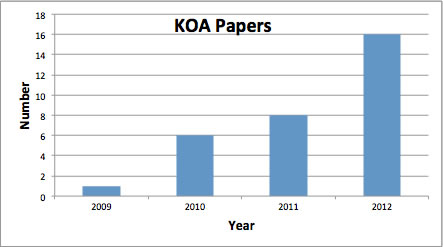
|
Instrument Usage and Efficiency
Barbara Schaefer, Observing Support Coordinator, WMKO
With the commissioning of MOSFIRE on Keck I, and the move of OSIRIS to the same telescope, the balance in instrument usage has naturally changed. The 3-D chart below shows the number of nights assigned to each instrument over the past five years.
In 2013, MOSFIRE is the most popular Keck I instrument. OSIRIS is seeing similar usage as it saw on Keck II, and DEIMOS has probably taken up some of the work previously assigned to LRIS. While OSIRIS has remained relatively steady, NIRC2 usage has increased significantly in recent years.
 |
On occasion we have acknowledged, for entertainment purposes only, the nights with the highest “duty cycle” for various instruments. The duty cycle is the fraction of time that is not weathered out during which the science shutter is open and the science camera collecting photons. With MOSFIRE the new kid on the block, observers have the opportunity to set new records in MOSFIRE “observing efficiency,” defined in this specific manner.
As of this writing, the record holders are Nick Konidaris and Andrew Newman, on March 28, 2013 (UT), with 75.02% efficiency. The following night, at 71.73%, the same pair took third place. Jason MacIlroy was the Observing Assistant (OA) on both nights. Marusa Bradac and Diego Alex Garcia-Appadoo took second place at 73.25% on June 13, with Julie Renaud-Kim running the telescope.
The largest amount of total open shutter time in one night was 7 hours and 49 minutes, by Peter Capak, Andreas Faisst, Marcella Carollo, and Sandro Tacchella on January 17, 2013 (Cindy Wilburn as the OA during that long winter night).
Other instruments had some notable nights as well. Richard Ellis and Sarah Miller (with Joel Aycock driving) had a DEIMOS night with 89.02% efficiency, good enough for fifth place on the all-time DEIMOS list. They did this on the auspicious UT date of 2012-12-12. Tucker Jones and Serio Belli turned in a performance of 90.84% with ESI (using the IFU) on 2013-03-07, with Carolyn Jordan as their OA. That was good enough for third place on the ESI list.
This is all for fun, of course. Other metrics would be more suitable for other projects, such as number of targets per night for a survey. But it is good to see MOSFIRE turning out to be a highly efficient instrument, a testament to the designers, builders, and observers and Observing Assistants. ✶
Preliminary On-demand Release of the Keck Observatory Logs Archive
Luca Rizzi, Support Astronomer, WMKO
Traditionally, visiting astronomers using the Keck instruments keep an accurate log of their observations on preformatted paper logsheets. This approach has several disadvantages: it is prone to errors, the logs are not searchable, they are not centrally archived, and they require a significant amount of manual data entry for information that is already available in the images headers.
Developed by Luca Rizzi in collaboration with Ian Cunnyngham as an Akamai internship project, a new web tool is now being offered which will gradually replace the need for paper logs. The new facility is called KeOLA: Keck Observatory Logs Archive. A screenshot of a typical log is shown in Figure 4.

|
Most of the information shown in this Figure has been automatically entered by the log facility. The observer still has the ability to add comments to the log, both on an image-by-image basis, and as a comment on the night overall, tagged with the time it is entered.
Every hour, the system also polls our weather station and enters the corresponding data into the log. At the end of the night, the logs can be printed as a PDF, as shown in Figure 5.
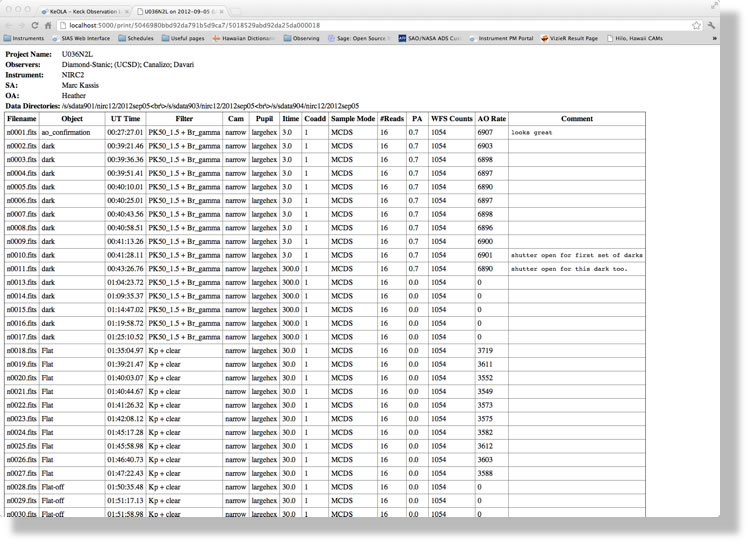
|
The log facility has been built so that it resembles the paper logs as closely as possible. When feasible, the same columns are shown as in the paper logs.
After a long series of tests, the log facility is now being offered on demand. Starting September 1st, if you are observing at Keck and would like to try our log facility, please ask your Support Astronomer, and the logs for your night will be started. This initial phase will allow us to collect input and feedback from observers before a final release is made.
For those concerned with security and privacy, it is worth mentioning that the log website is only accessible from within Keck. When the facility is fully deployed, a PDF copy of your logs will be made available through your observer’s login page, and will be therefore password-protected.
Eventually, we would like to integrate our log facility with KOA, so that while you retrieve your images you will be offered the possibility of retrieving the log associated with them, and vice versa.
We welcome your input and feedback on all these ideas. ✶
Remote Ops Says "Sayonara!" to Sun/Solaris
Gregory D. Wirth, Support Astronomer, WMKO
Ever since remote observing with the Keck telescopes began in the mid-1990s, observers at the Remote Observing facility at Waimea's WMKO Headquarters building have used some flavor of Sun workstation to operate Keck instruments. These machines proved highly reliable over their many years of service, but they are aging and must be replaced. The Observatory's software group recently completed a trade study to identify a more promising path for future computer platforms and has selected Linux as the new operating system of choice.
A team of Keck staff involving software engineers, system administrators, and support astronomers is collaborating in an effort to phase this new hardware into Waimea Remote Ops. The first machine to have been commissioned is the new observers’ workstation in Remote Ops II, which was released for observer nighttime use in mid-June and has been working well overall.
Since all instrument interfaces now routinely run within VNC (Virtual Network Computing) servers, the experience of operating the software from the new computer is almost exactly the same as the old. The change most observers will notice is that the new Linux computers are equipped with several of the higher-resolution (1920x1080) monitors commonly in use today. Upgrading these screens in Remote Ops will allow us eventually to increase the size of the VNC servers used for instrument software, giving you more virtual screen real estate within your instrument VNC sessions whether you observe from Waimea or one of our numerous “Mainland observing” sites.
In the months to come, we will be replacing virtually all of the computers in Waimea Remote Ops with new Linux machines, and the Sun will set (figuratively speaking) on the Solaris era in Remote Ops. ✶
New Post–Observing Comments Form
Robert W. Goodrich, Observing Support Manager, WMKO
One of the more important avenues of communication between the Observatory and its observers is through the Post-Observing Comment (POC) form. This allows observers to tell us how their observing run went, what went well and what needs improvements. Historically roughly 25% of observers have submitted POC forms, and we value this information enough that we have released a new version of the form.
The prose encouraged in the previous POC form allows observers to precisely describe any observing details. This is of vital importance, and you will be able to write anything you like into the new form. However, for tracking trends in observer satisfaction, we have also added a handful of numeric rankings. These will allow us to look for trends in various categories of support to determine whether we need to work on those aspects.
The new form will be accessible only through the WMKO Observer Home Page at https://www2.keck.hawaii.edu/inst/PILogin/homepage.php. A gentle “reminder” has also been initiated for those observers who forget to fill out the POC form at the end of a long night of observing, or who would prefer to think about their input after they return to their home institution. When a reminder is sent out for an observing run, it will be sent to all observers listed on the telescope schedule. The link provided in that e-mail will contain enough information to identify the run, and prefill some of the information such as dates, instrument, program title and abstract, etc. The idea is that one of the observers should take ownership of filling out the form, although we don’t mind if multiple observers fill out separate forms. Only one reminder will be sent out, although you will always be able to access the form for your observing run through your Observer Login page.
Parts of the form are shown below. We look forward to receiving feedback on your observing runs.
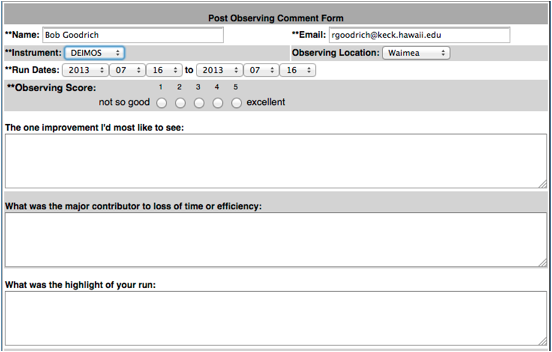
|
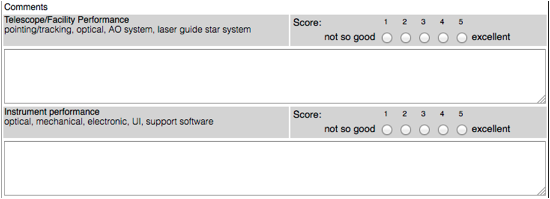
|
New Gold-Coated Gratings for the LRIS Red Side
Luca Rizzi, Support Astronomer, WMKO
The red arm of LRIS is now equipped with three new gold-coated gratings, bringing to a successful completion a project started in 2010 to take advantage of the greatly improved long wavelength sensitivity of the LBNL fully depleted CCDs installed during the LRIS red upgrade.
The new gratings were delivered to Keck in 2012, but a significant amount of work was needed to manufacture three new installation holders. The holders arrived at Keck in January of 2013, and were installed in LRIS. Intensive testing was performed on the gratings, and the LRIS software was modified to handle the new wavelength calibrations.
We are happy to report that we can now offer new 600/10000, 831/8200, and 1200/9000 gratings.
In the course of an engineering night, we compared the performance of the new gold-coated 831/8200 vs. the old aluminum-coated grating, by taking spectra of the same spectroscopic standard. Figure 8 shows throughput measurements for the two gratings, with values as high as 35 % for the gold grating at 9000 Angstrom.
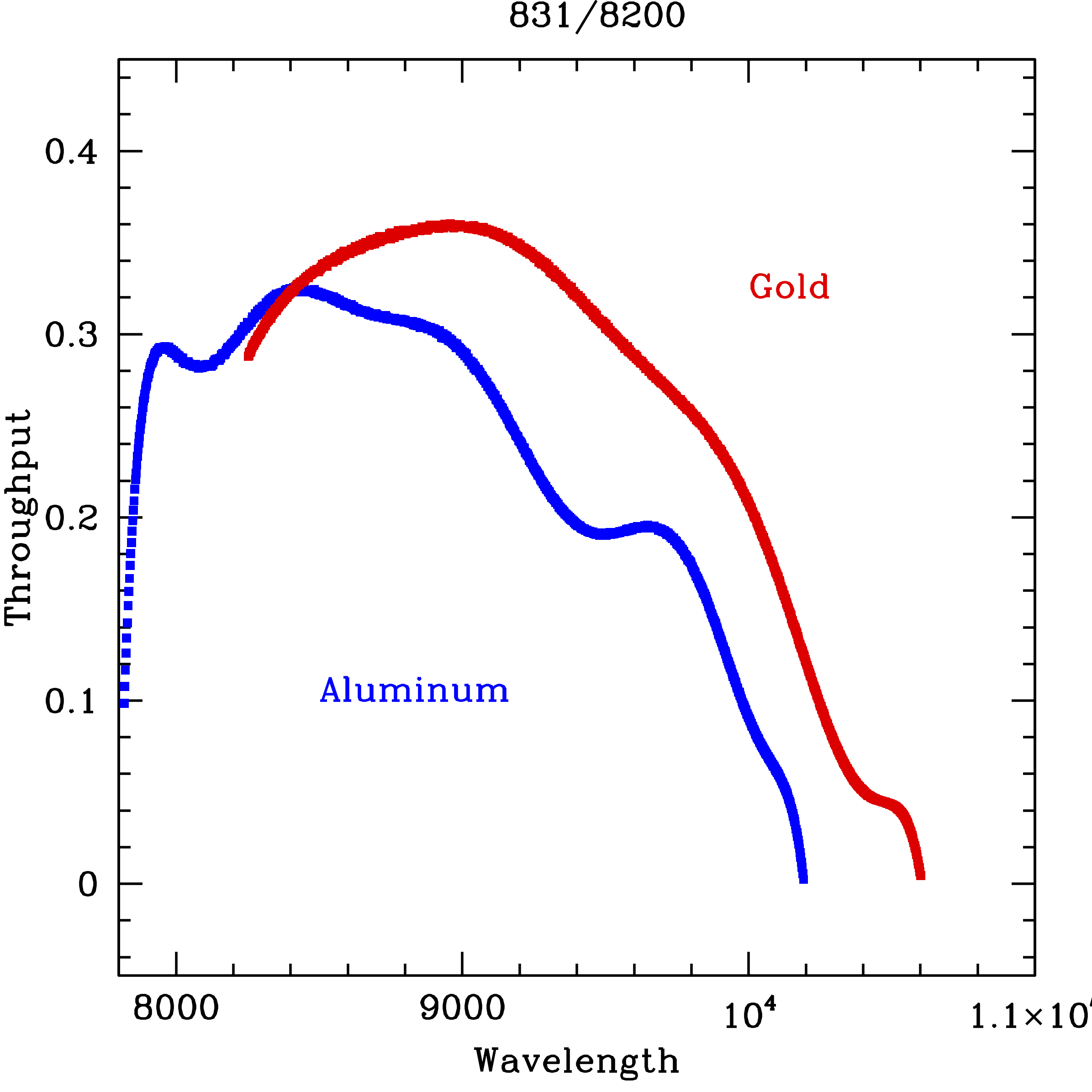
|
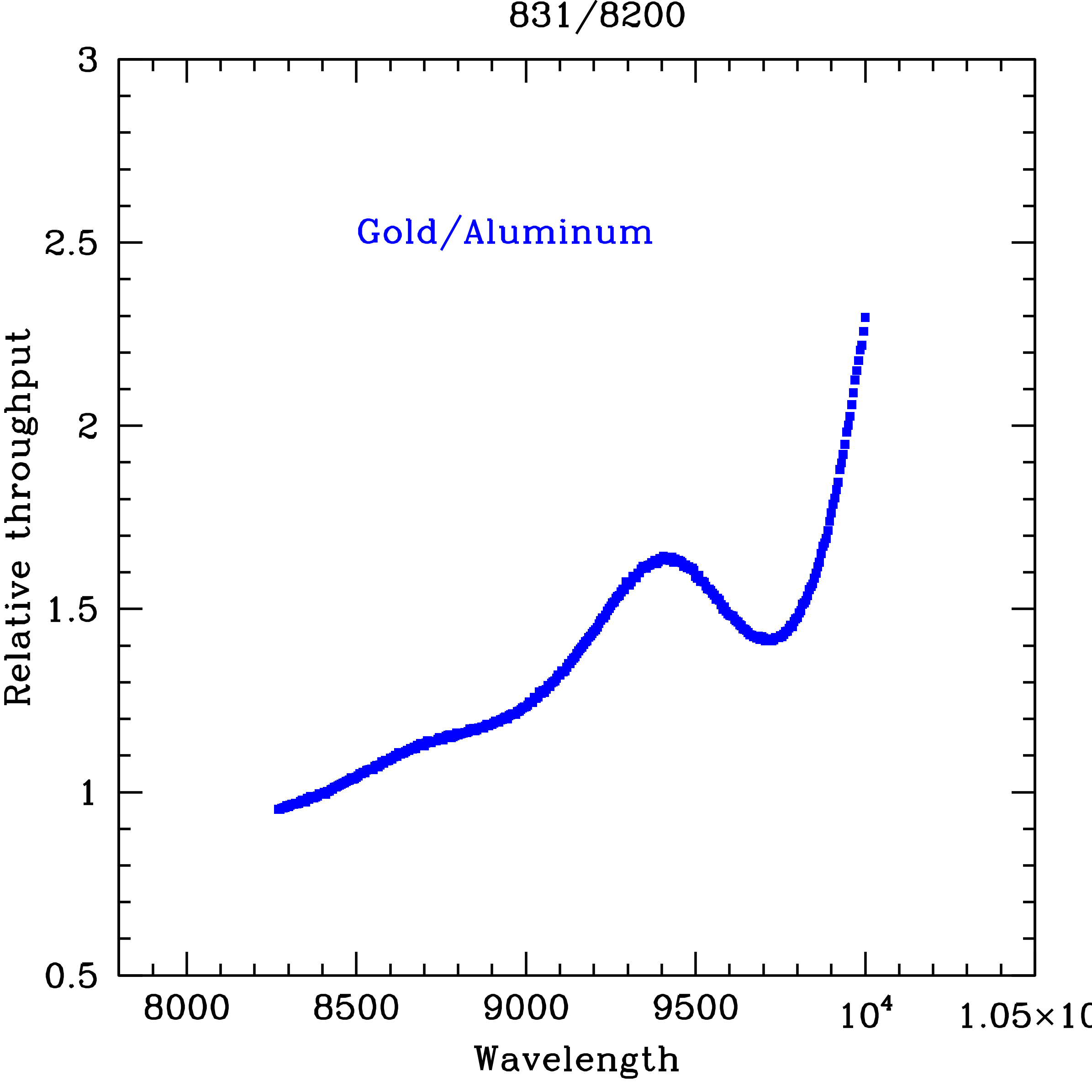
|
The gain is even more obvious when the relative throughput is considered, as shown in Figure 9. Between 9,000 and 10,000 angstroms, the efficiency is increased by as much as a factor of 2.
Dynamics of compact red galaxies, spectroscopic confirmation of high-redshift clusters, cosmology with supernovae Ia at z > 1, and highly magnified high-redshift galaxies are just some of the science cases that will strongly benefit from these new gratings. The successful completion of this project has been made possible by the dedication of Marc Kassis, Support Astronomer at WMKO, and by the invaluable expertise of the summit instrument team. ✶
OSIRIS DRP Handover
Jim Lyke, Support Astronomer, WMKO
Raw OSIRIS images are extremely complex and require a data reduction pipeline (DRP) to be useful to astronomers. Keck observers have long benefitted from behind-the-scenes help in DRP maintenance by the UCLA OSIRIS team and many others. The time has come for Keck to assume responsibility for the OSIRIS DRP. Soon, a new version of the OSIRIS DRP will be released. It will be available for download on the Keck website and features an improved install script by Jen Holt, Keck�s new scientific programmer. There are several changes to the DRP including: 1) new wavelength solution for the new grating; 2) date-coded wavelength solutions so one may more easily reduce old data; 3) new parameters for the K1 AO bench dispersion; 4) correction for a misplaced column in raw data; and 5) correction for the image flip on Keck I. The installation script now logs its output and allows observers to update the IDL code only. Additionally, the OSIRIS DRP works in 64-bit mode. Once released, we will contact OSIRIS observers. We are excited by these improvements and are very thankful for all the support that the OSIRIS DRP developers, especially James Larkin (UCLA), Shelley Wright (U of Toronto), and Tuan Do (U of Toronto), have given Keck and OSIRIS observers over the last eight years. ✶
Back Issues
Please see the Keck Observers’ Newsletter Archive.
Issue 15
Summer 2013
Contents
Preliminary On-demand Release of the Keck logs �
New POC �

